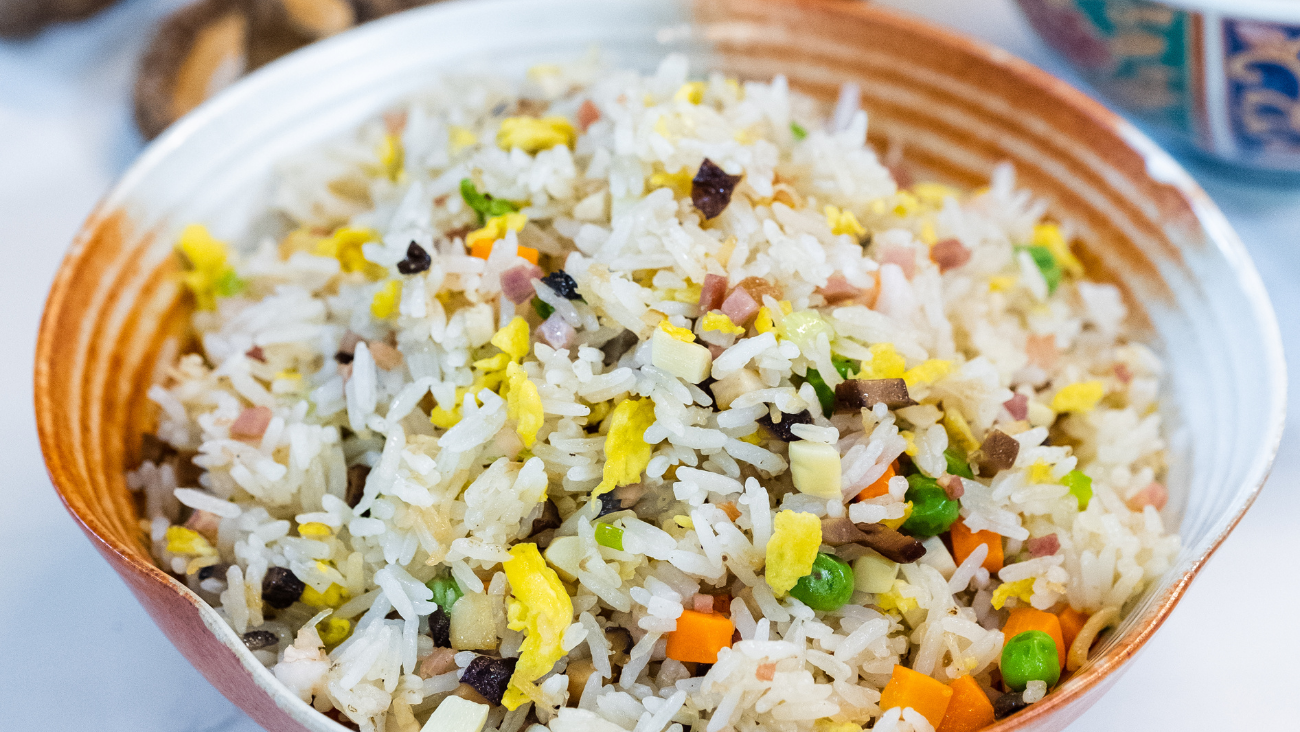Today, we are making Yang Zhou Fried Rice (扬州炒饭). A lot of people think it just is egg-fried rice, which is correct because there is egg in it but it is not as simple as you think. Today, I will show you how to make it authentic by following the industry-standard recipe. You didn’t hear me wrong, Yang Zhou Fried rice has a very strict standard which is published by Yangzhou Quality and Technical Supervision Bureau. If the local restaurants don’t follow the rules, they cannot name their fried rice after Yangzhou. So, stick with me and you will be surprised how much work and effort goes into this dish.

INGREDIENTS
- 3 cups (600 grams) of leftover rice
- 2 eggs
- 3 tbsp of cooking oil
- 4 grams of bamboo shoot, diced
- 40 grams of carrot, diced
- 40 grams of pea
- 3 shitake mushrooms, diced
- 3-5 pieces of rehydrated dried scallop
- 40 grams of Jin Hua ham, diced
- 40 grams of chicken thigh, diced (you can also use chicken breast)
- 1.5 tbsp of chinese cooking wine
- 40 grams of shrimp, diced
- 40 grams of rehydrated sea cucumber, diced
- 20 grams of scallions, diced
- 1+1/4 tsp of salt
- 3 tbsp of cooking oil
There are a lot of preparations needed to be done ahead of time; I will go through them one by one.
First thing first – the rice. I am using day-old Jasmine rice. You can also use leftover rice from takeout. If you don’t have any, you can cook it one day ahead. I do have a video that explains how I prepared my rice. You can click here to check it out because the fluffiness of the grains determines the final result of this dish.

Sea cucumber is the luxury part of this recipe. Depending on the quality and varieties, the price can be between 400 to thousands of dollars per pound. Don’t worry, you can replace it with fresh sea scallop. Rehydrating dried sea cucumber is an extremely time-consuming process, which includes 48 hours of soaking, 1-3 hours of simmering, then another 48 hours of soaking. That is why only time-honored local restaurants will do this. Since it is complicated, I separated that process into a different video, if you are interested, you can click here to learn how to prepare dried sea cucumbers.
Once the sea cucumber is properly rehydrated, it will be 10-15 times the size. We only need 40 grams for this recipe. That will be 1/2 of this guy. You can stick the rest into the freezer and save it for a different dish. Dice the sea cucumber finely.

Soaked 3 dried shitake mushrooms and 3-5 dried scallops 2 hours ahead. Could fresh ones work? The answer is yes but they won’t taste the same because they developed lots of umami flavor during the dehydration process. These two are the most basic Chinese dried ingredient. You can buy them in almost any Asian grocery store. I also have a demo video of how to dehydrate your own. You can click here to check it out.

Squeeze the mushroom to remove water then dice it finely. Put the scallop in a small blender to blend for 10 seconds or until it becomes nice and fluffy.

This is Jin Hua ham – a special cured meat from Jin Hua, Zhe Jiang province. It was listed as a tribute from Song Dynasty to Qing Dynasty. If you don’t have access, a thick cut of Italian prosciutto will do just as good.

Put 40 grams of Jin Hua ham and 40 grams of chicken breast into a bowl and drizzle in some Chinese cooking wine. Transfer into a steamer and let it steam for 20 minutes.
20 minutes later, take the bowl out. You will see some liquid in the bowl; that is the purpose of this steaming process because we can use it to flavor the rice at the end.

Dice 40 grams of shrimp. Pre-blanched some diced vegetables by putting them in boiling water for about 40 seconds. Quickly crack 2 eggs and whisk them until you don’t see any obvious egg white.

Let me explain why we dice all the ingredients so small. 2 reasons: First, the smaller the ingredients are, the more evenly they can be distributed into each bite. Second, the rice should be the star of this recipe – everything else there just for auxiliary purposes, no matter how expensive they are. That is why we cut everything so small. If the shrimp or other ingredients are too big, they will be attractive and take your attention off the rice.
You might notice that the measurement for each of these ingredients is quite small; that is because this is a standard recipe for restaurants. They usually process a large amount of the ingredients and use a little bit of each when they take the order from the customer. So, if you are making it at home, it is ok to skip or double a couple of ingredients.
Now, we have everything now, let’s cook.
Heat your wok until smoking hot. Add a few tbsp of oil. Toss in the egg. Get a pair of chopsticks and stir this as fast as you can. In about 3 minutes, all the eggs will be crumbled into these small little bits – that is exactly what we want. The egg pieces should be small and match the size of the other ingredients. If not, you can dice it on the cutting board. Turn off the heat. Squeeze the egg with your spatula so you can get rid of the oil – this is important. we don’t want the fried rice to come out oily.

Set the egg aside. Check how much oil you have left in the wok, I got about a tbsp, which is enough. If not, you can add a little more. Turn the heat back on high. Toss in the jin hua ham, shredded scallop, diced shitake mushroom, sea cucumber (or fresh scallop), shrimp, and chicken thigh. Although the ham and the chicken thigh are already cooked, sautéing them for a couple of minutes will active more flavors. Add in the cooked day-old rice; keep stirring on high heat for a few minutes. Make sure you use a large wok because it really makes big difference. Thoroughly stirring the ingredients in a super-hot wok will create a complex, smoky aroma we call it wok hay, also known as the breath of the wok – without that your fried rice is missing the soul. When you see some grains dancing and jumping at the bottom of the wok like that, you can add the blanched vegetables and the egg. Drizzle in the steaming liquid. Keep stirring until everything is well mixed. Add some salt to taste. I used 1 tsp + 1/4 tsp. Give it a final toss. Before serving, sprinkle some diced scallion and your fried rice is done. Look at this, the rice is so fluffy, each grain is separated individually.

From each bite, you can taste the character of the different ingredients, such as the gooeyness from the sea cucumber, the crunchiness from the bamboo shoot, the freshness from the shrimp, sweetness from the carrot and peas, while the rest of the umami ingredients are pleasantly pungent. Everything together is supporting the rice – what an incredible experience! This is going to be the best fried rice you will ever have.







































































